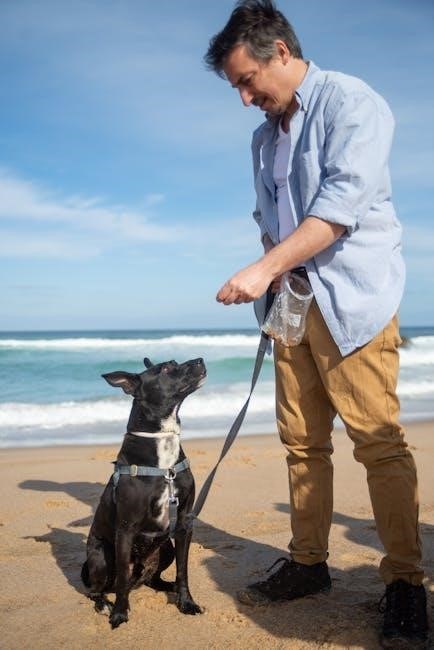Mastering Puppy Potty Training: A Comprehensive Guide for Busy Pet Owners
Consistency and routine are key to successful puppy potty training. Busy owners should take their puppy outside 8-10 times daily‚ especially after meals‚ naps‚ and play. Positive reinforcement and quick breaks can make the process efficient.
Understanding the Basics of Puppy Potty Training
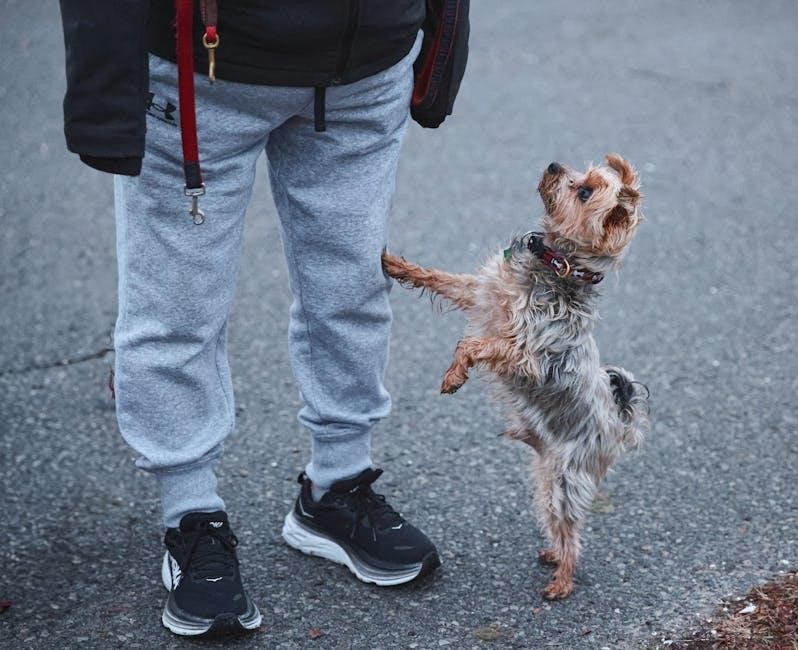
Understanding the basics of puppy potty training is essential for any new pet owner. Puppies‚ especially in the early stages‚ have limited bladder control and need frequent trips outside. On average‚ a puppy may need to go potty 8-10 times a day‚ particularly after waking up‚ eating‚ drinking‚ or playing. This frequent need is due to their small digestive systems and high metabolism. Consistency is key‚ as puppies thrive on routine and clear communication.
A puppy’s ability to hold their bladder is directly tied to their age. For example‚ a 4-month-old puppy can typically hold their bladder for about 4 hours‚ while younger puppies may need more frequent breaks. Recognizing signs that your puppy needs to go‚ such as sniffing or circling‚ can help prevent accidents. By establishing a predictable schedule and responding to these cues‚ you can set your puppy up for success.
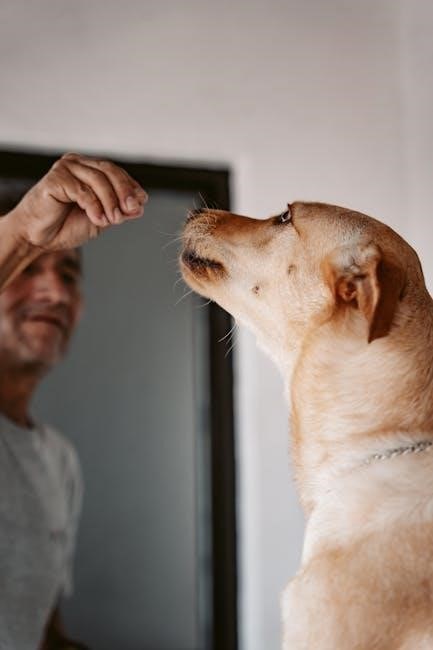
Busy pet owners should aim to create a simple yet effective routine that fits their lifestyle. This foundation will make the rest of the training process smoother and less stressful for both you and your puppy. Remember‚ patience and consistency are your greatest tools.
Essential Supplies for Effective Puppy Potty Training
To ensure a smooth potty training process‚ gathering the right supplies is crucial. Start with a high-quality crate that provides a safe space for your puppy and helps with containment. Food and water bowls‚ a comfortable bed‚ and a collar with identification tags are also must-haves. A leash and harness are essential for outdoor trips‚ while potty pads or newspapers can serve as indoor alternatives during early training. Treats and toys are vital for positive reinforcement‚ rewarding your puppy for successful potty breaks. Cleaning supplies‚ such as pet-safe disinfectants‚ are necessary for accidents. Lastly‚ consider outdoor gear like a poop scoop and waste bags for cleanups. These supplies create a structured environment‚ making training easier for busy owners. By having everything ready‚ you can focus on consistency and building good habits for your puppy. Proper preparation ensures fewer setbacks and a more enjoyable training experience for both you and your furry companion.
Establishing a Consistent Routine for Busy Schedules
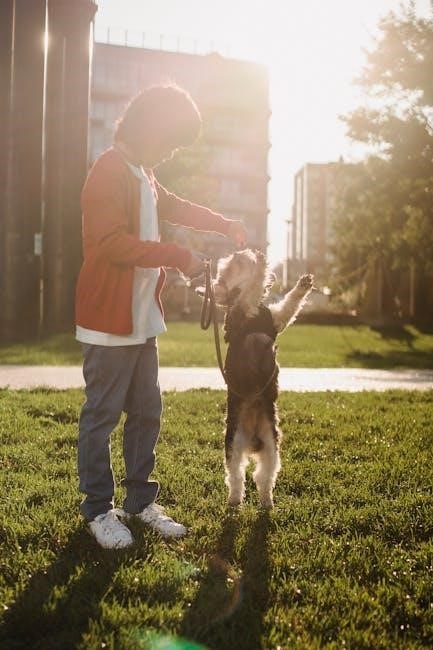
Creating a consistent routine is vital for successful puppy potty training‚ even for busy pet owners. Start by taking your puppy outside immediately after waking up‚ eating‚ drinking‚ or playing. These moments are critical as puppies typically need to go within minutes of these activities. Schedule regular breaks every 1-2 hours‚ or more frequently for younger puppies‚ to prevent accidents. For busy owners‚ incorporating potty breaks into your daily routine‚ such as during work-from-home breaks or before leaving the house‚ can help maintain consistency. Use a timer or app to remind yourself when it’s time for a potty break. Over time‚ your puppy will learn to associate these moments with the need to go outside. Stick to a feeding schedule to help regulate your puppy’s bathroom needs‚ making it easier to plan your day. Consistency‚ even on weekends or days off‚ ensures your puppy learns faster and reduces the risk of setbacks. A structured routine is key to balancing a busy lifestyle with effective potty training.
The Role of Positive Reinforcement in Potty Training
Positive reinforcement is a powerful tool in puppy potty training‚ helping your puppy associate going potty outside with desirable outcomes. Every time your puppy successfully goes potty in the right place‚ reward them with treats‚ praise‚ or playtime to reinforce good behavior. Consistency is key—immediately reward your puppy to help them connect the action with the reward. Use specific commands like “go potty” to create a clear association. Over time‚ your puppy will learn to go potty on command‚ making the process faster and more efficient. For busy owners‚ incorporating quick praise and small treats into your routine ensures positive reinforcement doesn’t take extra time. Avoid punishing accidents‚ as this can create negative associations and slow progress. Instead‚ focus on celebrating successes‚ no matter how small‚ to build your puppy’s confidence and motivation. Positive reinforcement not only speeds up training but also strengthens the bond between you and your puppy‚ creating a foundation for lifelong good behavior.
Handling Accidents and Setbacks Like a Pro
Accidents are an inevitable part of puppy potty training‚ even for the most diligent owners. When your puppy has an accident indoors‚ it’s crucial to remain calm and avoid punishment. Yelling or scolding can create negative associations and hinder progress. Instead‚ gently redirect your puppy to the designated potty area. Clean up accidents thoroughly with a neutral-smelling cleaner to remove any lingering scents that might attract your puppy to the same spot again. If your puppy is still having frequent accidents‚ reassess their routine to ensure they’re being taken out frequently enough‚ especially after meals‚ naps‚ and playtime. Setbacks‚ such as regression in training‚ can occur due to changes in routine or stress. Stay consistent and patient‚ as these challenges are temporary. Busy owners can benefit from keeping a potty schedule checklist to track progress and identify patterns. Remember‚ every puppy learns at their own pace‚ and with persistence‚ your puppy will master potty training.
Time Management Tips for Busy Pet Owners
For busy pet owners‚ balancing puppy potty training with a hectic schedule can be challenging but manageable. Start by creating a structured routine that aligns with your daily commitments. Schedule potty breaks immediately after your puppy wakes up‚ eats‚ drinks‚ or plays—times when they’re most likely to need to go. Use a timer or app to remind you when it’s time to take your puppy outside‚ ensuring consistency even on your busiest days.
Incorporate crate training to help manage accidents when you’re unable to supervise. A crate teaches your puppy to hold their bladder and bowels‚ reducing the likelihood of setbacks. If you’re short on time‚ opt for quick potty breaks in a designated area‚ praising your puppy when they succeed. Consider enlisting help from family members or hiring a dog walker for midday breaks if possible.
Stay organized by keeping a potty schedule checklist to track progress and identify patterns. Busy owners can also benefit from using absorbent pads or a small potty area indoors for emergencies. Remember‚ consistency and patience are key—every small step counts‚ and with efficient time management‚ your puppy will learn to go potty where and when they should.
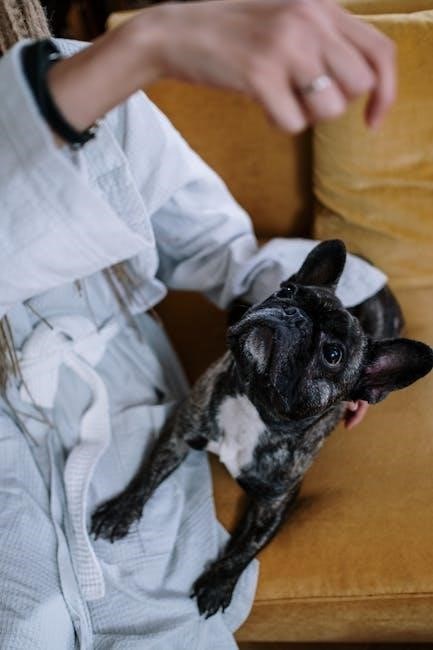
Common Challenges in Puppy Potty Training
Puppy potty training can present several common challenges‚ especially for busy pet owners. One of the most frequent issues is inconsistent scheduling‚ which can confuse your puppy and lead to accidents. Puppies thrive on routine‚ so missing a scheduled potty break can quickly undo progress. Another challenge is distractibility; while outside‚ your puppy might focus on exploring or playing rather than going potty‚ requiring patience and clear commands to stay on task.
Additionally‚ inclement weather can discourage both puppies and owners from venturing out‚ leading to delays or skipped breaks. This is particularly true for breeds that are sensitive to cold or wet conditions. Medical issues‚ such as urinary tract infections or gastrointestinal upset‚ can also disrupt training and require veterinary attention. Busy schedules often leave little room for unexpected setbacks‚ making it crucial to remain flexible and adaptable.
Finally‚ young puppies may not have the bladder control to hold their urine for long periods‚ especially smaller breeds. This means frequent trips outside are necessary‚ even if it disrupts your busy routine. By anticipating these challenges‚ you can better prepare and adjust your training strategy to ensure success.
The Importance of Crate Training in Potty Training
Crate training is a powerful tool in puppy potty training‚ especially for busy pet owners. A crate helps your puppy learn to hold their bladder and bowels by tapping into their natural instinct to avoid soiling their sleeping space. This method is particularly effective because puppies are reluctant to urinate or defecate in small‚ enclosed areas where they rest.
By confining your puppy to a crate when you’re unable to supervise‚ you reduce the risk of accidents in the house. The crate also serves as a safe space for your puppy‚ preventing destructive behavior and anxiety. When used correctly‚ crate training accelerates the potty training process by teaching your puppy to wait until they are taken outside.
For busy schedules‚ crates are invaluable because they provide a secure environment for your puppy when you’re away. However‚ it’s important to avoid leaving your puppy in the crate for too long‚ as this can lead to frustration and setbacks. Crate training‚ when combined with consistent breaks and positive reinforcement‚ is a game-changer for successful potty training.
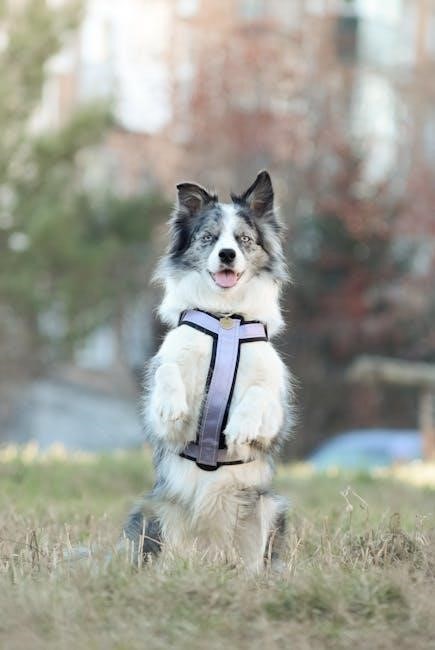
Advanced Strategies for Faster Potty Training
Advanced strategies can significantly speed up the potty training process‚ especially for busy pet owners. One effective method is the “umbrella technique‚” where you watch your puppy closely and immediately take them outside upon showing signs of needing to go. Another strategy is using a bell or button system‚ allowing your puppy to communicate their need to go potty‚ which fosters independence and reduces reliance on constant monitoring.
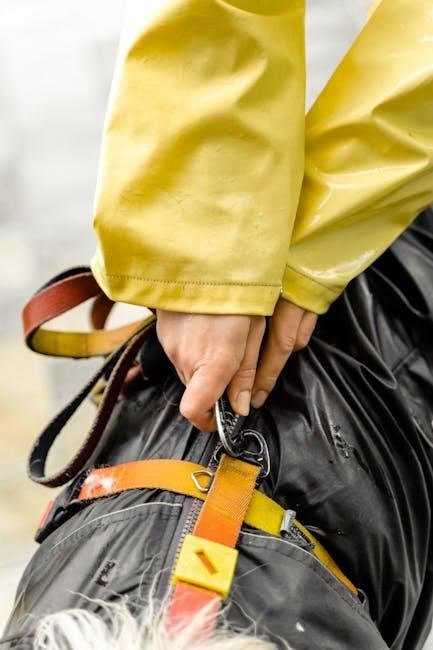
Timing is crucial. Take your puppy outside immediately after high-activity periods like playtime or meals‚ as these often trigger the need to go. Utilizing specific commands like “go potty” during these moments can help your puppy associate the command with the action‚ making training more efficient.
For busy schedules‚ incorporating short but frequent breaks is essential. Even five-minute trips outside can prevent accidents. Additionally‚ using high-value rewards during successful potty breaks can motivate your puppy to learn faster. Consistency and patience are key to mastering these advanced techniques and achieving long-term success.
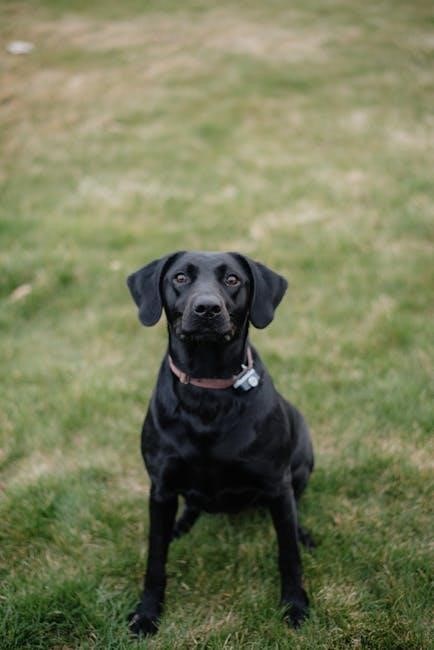
Celebrating Progress and Maintaining Long-Term Success
Celebrating small victories is essential to keep both you and your puppy motivated throughout the potty training journey. Acknowledge progress‚ no matter how minor‚ with treats‚ praise‚ or playtime to reinforce positive behavior. As your puppy becomes more reliable‚ you can gradually increase their freedom in the house‚ such as granting access to more rooms or extending the time between supervised breaks.
Maintaining long-term success requires consistent routines and ongoing vigilance. Even after your puppy is fully trained‚ occasional accidents may occur due to health issues‚ changes in environment‚ or stress. Stay proactive by monitoring your puppy’s behavior and adjusting your approach as needed. Celebrate milestones‚ like reaching a full month without accidents‚ to reinforce the bond between you and your puppy.
Remember‚ potty training is a process that evolves over time. By staying patient‚ positive‚ and adaptable‚ you can ensure long-term success and a happier‚ healthier relationship with your furry companion.
